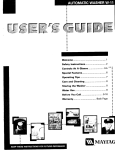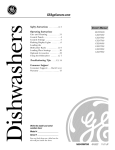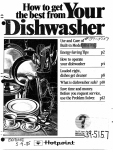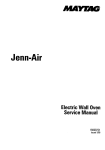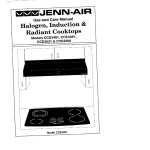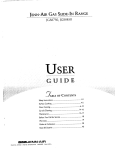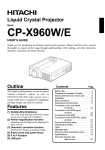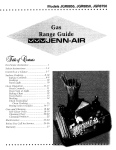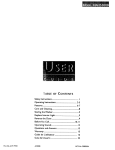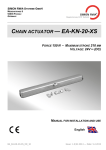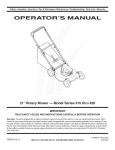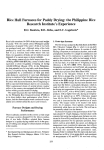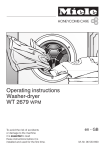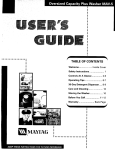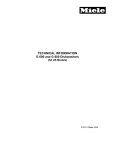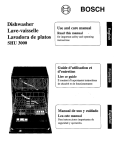Download Jenn-Air JDB8910 Dishwasher User Manual
Transcript
Dishwasher
Guide
=JENN-AIR
For Future Assistance
Safety Instructions
Loading
................
..................
the Dishwasher
Dishwashing
1
Essentials
1
............
2-4
..............
5
Controls At A Glance ................
6
Operating
7
Tips ......................
Starting the Dishwasher
Adding
a Forgotten
What Can & Cannot
Care & Cleaning
Common
Warranty
Questions
Item
.............
7
............
Be Washed
.......
...................
& Answers
........................
7
7
8
.....
9-10
11
_
Note: In our continuing effort to improve the
quality of our appliances, it may be necessary to
make changes to the appliance without revising
this guide.
Llame al telefono 1-800-688-1100 si desea
instructiones en Espafiol de este folleto, numero
de pieza 16009803.
Part No. 6 915722A
.....
.
]For
Future
Assistance
Congratulations on your choice of a Jenn-Air dishwasher!
Before you use your new appliance, please read this guide
carefully. You will find instructions on the proper operation
and maintenance of your new dishwasher.
Please record the date of purchase, model, and serial number in the spaces provided below. Model and serial numbers can be found in the upper left of the tub opening.
Date of Purchase
Model Number
_WARNING
- Check with the installer to make sure
the appliance has been properly grounded to avoid possible electrical shock. Be sure you read the Important
Personal Safety Instructions before you start to use this
dishwasher.
If you have questions, write us (include your model, serial
number and phone number) or call:
Serial Number
Jenn-Air Customer Assistance
Maytag Appliances Sales Company
Attn: CAIR sMCenter
EO. Box 2370
Cleveland, TN 37320-2370
a safe place for future reference. Proof of original purchase date is needed for warranty service,
l IMPORTANT: Keep this guide and the sales receipt in
1-800-688-2080 TTY USA (for deaf, hearing
impaired and speech impaired)
1-800-688-1100 USA and CANADA
Internet: http://www.jennair.eom
Important
Safety
Instructions
Products with a®label have been listed with Underwriter's
Laboratories, Inc. - those with a CSA tag have been listed
with Canadian Standards Association. Nevertheless, as
8. Do not touch the heating element on the bottom of the
tub during or at the completion of a cycle. It will be
hot.
with any other equipment using electricity and moving
parts, there is a potential hazard,
9. Use only detergents and rinse additives designed for an
automatic dishwasher. Never use soap, laundry deter-
basic precautions, including the following:
I,WARNiNG_Whenusingyourdishwasher,
follow I
1. Read all instructions before using the dishwasher.
Keep these products out of reach of children.
gent, or hand washing detergent in your dishwasher.
10. Do not sit, stand on or abuse the door or dish racks of
the dishwasher.
2. Use the dishwasher only for its intended function.
3. Disconnect electrical power to dishwasher before
attempting to service,
11. Under certain conditions, hydrogen gas may be produced in a hot water system that has not been used fo_
two weeks or more. Hydrogen gas is explosive. If th_
hot water system has not been used for such a period
turn on all hot water faucets and let the water flov
from each for several minutes. This will release an_
accumulated hydrogen gas. As the gas is flammable
do not smoke or use an open flame during this proces_
4. To avoid electrical shock hazard, the sides and back
must be enclosed and the front panels must be attached
before electrical power is applied to the dishwasher.
Refer to the installation instructions for proper grounding procedures.
5. Connect to a properly rated, protected and sized power
supply circuit to avoid electrical overload,
6. Children should never be permitted to operate, or play
in, with, or around this dishwasher.
7. To reduce the risk of injury when loading items to be
washed, sharp or pointed items should be located with
the handles up. Also, load sharp items so they are not
likely to damage the door seal.
12. Do not wash plastic items unless marked "dishwashe
safe" or the equivalent. For plastic items not s
marked, check the manufacturer's recommendations.
13. Do not tamper with controls.
14. Always remove the door to the washing compartmel
when removing an old dishwasher from service or di
carding it.
Save These Instructions
#
Loading
Getting
the
Dishwasher
Started
• Don't Prerinse. Simply scrape off any bones or large
food particles,
• Items can be centered behind a single tine or loaded at
an angle to maximize space.
• If connected to a food waste disposer, make certain the
disposer is empty before starting the dishwasher,
• Load items so they do not rest over the top of the wash
tower.
• Remove certain foods (such as mustard, mayonnaise,
lemon juice, vinegar, salt or dressings) from stainless
• Avoid blocking the upper and lower spray arms by not
allowing items to extend beyond the racks.
steel flatware as soon as possible. These foods may
cause rusting and pitting if allowed to remain in contact
with the surface for an extended period of time.
R e c o rn m e n d e d L o a d i n g
{Rack
]
Place all items in the racks so they are separated and facI ing center.
featuresvaryby
model}
For best dishwashing results follow these guidelines to determine the best arrangement for your items.
Upper
Rack
The Vari-Lock Snugger on the left secures lightweight
items in place. It can be adjusted by grasping the wavy
wire and rotating it left to snug items against the outer rack
or to the right to rest on top of light items. Do not load
items on top of the wire.
TM
......
_
The wavy wire on the Vari-Lock '_'Snugger and the Stack-
10 Place Settings
Rack is designed to hold stemware in place. Taller
stemware will fit better on the right side as the upper rack
is deeper on this side.
Glasses, cups, stemware, light-weight plastics, small
plates, bowls, pans, long-handled utensils etc. can be
loaded in this rack. Do not load glasses over the tines.
Correct
Incorrect
Tine
in
The Stack-Rack on the right side of the upper rack folds up
or down for loading flexibility. Fold it down to hold longhandled knives, spatulas and spoons or short items like
cups or juice glasses. Fold it up for taller items like glasses, bowls, plates, etc.
oa di ng th e Di s h was h er (con t).
The Adjustable Upper Rack can be raised to accommodate
taller plates, platters, pans, etc. loaded in the lower rack.
To raise the rack:
• Pull the rack fully out.
• Grasp the handle on the right rear side of the rack.
• Lift and pull the rack slightly forward to lock up into
place.
To lower the rack:
• Pull the rack fully out.
• Grasp the handle on the right rear side of the rack.
• Lift and push the rack slightly back to lock back down
into place.
Lower
Rack
A variety of large items such as dinner plates, mixing bowls, pots and pans and baking dishes can be loaded in this rack.
3 saucers
are loaded
on the rack
under the
St
Shelf
With the Stack-Rack shelf raised, thin items like cookie
sheets or pizza pans may be placed along the left side. With
the shelf down, two levels of glasses and cups can be
loaded.
10 Place Settings
Positioning the Fold-Away '_ tines flat in the back comer
provides convenient loading space for large bulky items
like pots and pans or mixing bowls.
Back
Tall items such as bakeware and large platters can be
placed on the left side or across•e the back of this rack.
J
Back
D O ® •
O •
0 O •
O •
•
O •
•
000
Convertible tines in the back, right comer can be adjusted
to provide narrow spacing for loading plates or wide spacing for loading deep bowls, pots or pans. Flip tines up for
narrow spacing or down for wider spacing.
Removable
Utensil
Basket
(Design varies by model)
Split & Fit
TM
Utensil
Basket
The split silverware basket can be separated and placed into
the bottom rack in several locations. Hold the basket firmly
and slide it apart until it splits into 2 baskets. Load flatware
and utensils into both sections or just one, depending upon
your load.
For best cleaning results, prevent items from nesting
together by placing some items in the basket with handles
up and some with handles down. Load knives, handles up,
through the slots in the hinged covered section(s) (when
closed).
Be sure that thin, finely pointed items do not extend
through the basket. This could block the lower wash arm.
Small, lightweight items like baby spoons and plastic measuring spoons should be placed in the section(s) with the hinged
cover(s).
Odds & Ends Basket
"\
Use this supplemental basket in the upper rack for loading
miscellaneous items and utensils. This is also a safe place to
load sharp knives and pointed items.
Removing
the
Upper
'___\l_h__
_,a__._es__,,_>____
Rack
The upper rack can be removed when tall or oversized items
need to be loaded into the lower rack.
[Note:Avoidrestingitemsoverthecenterwashtower.
]
To remove:
¢_'Roll the upper rack 1/3 to 1/2 of the way out.
_ Remove the plastic rack stop from the end of each
track. To remove each plastic rack stop, push inward
(towards the rack) on the ridged area of the rack stop.
The rack stop will snap open and can be easily
removed by pulling straight out. Take care to support
the track while removing rack stops.
Roll the rack all the way out of the track and remove
from the dishwasher.
4_Reverse the above procedure to replace the upper
rack into the dishwasher.
Rack
Dishwashing
Hot
Essentials
Water
For optimal cleaning and drying results, hot water is
necessary. The incoming water temperature should
be 120-140 ° F (49-60 ° C) to properly activate the
detergent and melt greasy food soils,
glass in the sink. Place a candy thermometer in the glass
and check the temperature once it has stopped rising. If the
To check the incoming water temperature, turn on the hot
water faucet nearest the dishwasher and let it run into a
Before
thethe
dishwasher,
turnThis
on the
hot water
faucet
and let itstarting
run until
water is hot.
assures
that the
initial fill of water is hot.
temperature is below 120° F (49° C), have a qualified person raise the water heater thermostat setting.
Detergent
Use a detergent designed specifically for use in an automatte dishwasher. Be sure it is fresh and stored in a cool,
dry place (not under the sink),
Recommended
Amount
Too little detergent results in poor cleaning, hard water
filming/spotting and poor drying. Too much detergent can
cause permanent etching/cloudiness.
For loads with food soils requiring the Heavy or Normal
cycles and/or hard water* conditions, fill both sides of the
Main Wash detergent cup. For loads with food soils requiring the Light or China/Crystal (select models) cycles
and/or soft water* conditions, fill the Light side of the
any dishwasher. A mechanical water softener may be necessary to improve water quality, detergent effectiveness,
and protect the dishwasher parts from the damage that hard
water can cause.
Water Hardness*
r
[ Soft (0-3 gpg) Medium (4-9 gpg)
I
Hard (10-12 gpg)
*Your local water utility or state university extension service can tell you the degree of water hardness in your area.
A
detergent cup only.
When using the Auto Clean cycle with heavily soiled
loads, fill both sides of the detergent cup. When using
Auto Clean with a lightly soiled load, fill the Light side
only.
1
|
Do not use detergent with Rinse Only. Leave the detergent lid open when running Rinse Only.
In extremely hard water conditions (15 grains per gallon gpg or harder*), it is difficult to achieve good results with
Rinse
Regular
Aid
use
of a rinse aid improves drying, reduces ]
spotting and filming, and reduces moisture left on the
dishwasher interior,
An automatic rinse aid dispenser is located next to the
detergent cups. The window next to the dispenser cap
indicates when the rinse aid reservoir needs to be refilled.
When the level of rinse aid is below the indicator marks
during the cycle is adjustable by moving the lever inside
the reservoir area. Use setting '°1" for soft water. Adjust
it up to the _MAX" setting for hard water. Set the lever
anywhere between these amounts as needed. Replace the
cap and turn it clockwise to close.
and the window is nearly clear, it is time to refill the dispenser. (Check the dispenser monthly).
To add rinse aid to the dispenser, turn the cap counterclockwise to open. Remove the cap and pour liquid rinse
aid into the opening. The amount of rinse aid dispensed
I
Full
•
Rinse
Aid
Improves
Drying1
I
t
|
Refill
Controls
Ultimate Quiet Series
I_l
Auto
Clean
Drain • Delay
Off • • Resume
At A Glance
Cycles
Oations
Rinse China Light Normal Heavy
Only Crystal Wash Wash Wash
Super Sa,itize Heated Extra
SetuP
[_ry
Rinse
Plus
Controlpanel styling varies by model.
Cycles
Auto Clean
Manufacturer's recommended cycle choice for all day-today soil types,
Normal dishloads vary from day to day. Auto Clean is recommended because it atttomatic',dly adjusts to each load,
offering the best combination of cleaning, energy consumption and water usage for that load.
Standard cycles:
Heavy Wash
Long cycle for heavy food soils,
Normal Wash
Medium cycle for average food soils.
Light Wash
Short cycle for light food soils.
China/Crystal (select models)
Short cycle with more gentle cleaning action.
Rinse Only
Rinses dishes being held until there is a full load. Controls
odors.
Select Sanitize with Auto Clean, Heavy, Normal, or
Light Wash to sanitize dishware. At the end of the cycle,
when the cycle monitor recognizes that the proper conditions have been met, the SANITIZED light illuminates.
Select Extra Rinse to add a rinse to the cycle. An extra
rinse helps to improve results in hard water situations. The
extra rinse is already built into the cycle when Heavy
Wash is selected.
Select Heated Dry to turn on the heating element during dry
for enhanced drying results. When Heated Dry is not selected, towel drying of some items may be necessary and more
moisture may be noticed adhering to the dishwasher interior. With either dry option, it is normal to notice vapor escaping from the door vent.
To
drain the
and then
it off,
Drain/Off
once.dishwasher
Press Drain/Off
twiceturn
to turn
the press
dishwasher off without draining.
*Brandnames,arethetrademarksof the respective manufacturer.
Cycle times shown in the numerical display increase or
decrease, based on each load's soil level, water temperature and selected options.
I n d i c a t o r Li gh t s
Wa t e r U s a ge
Note: When Sanitize is selected, cycles are monitored to }
assure sanitization. Unusually low water temperature will
prevent the sanitizationprotocol from being satisfiedand the
SANITIZED light will not illuminateat the end of the cycle.
CLEAN illuminates at the end of the cycle and remains lit
until the door has been open for 30 seconds continuously.
Rinse
Only
China
Crystal
I-I
Light
--AutoClean
Normal
I
I
Heavy
1 Fill
3 Fills
2 Fills
3 Fills
4 Fills
5 Fills
2.1
5.0
4.1
6.(/
8.0
9.9
gallons
gallons
gallons
gallons
gallons
gallons
SANITIZED illuminates at the end of the cycle when conditions have been met to achieve sanitization.
I
DRY illuminates during the entire dry period and goes out
when the cycle is completed.
Op tion s
WASH illuminates during the prewash and wash portions
of the cycle. In some models, WASH also illuminates duringthe final rinse.
Select
Scrub Plus when washing loads with hard-toremoveSuper
food soils.
RINSE (select models) illuminates during the final rinse.
This option can be selected with any cycle (except Rinse
Only). Depending on the cycle, Super Scrub Plus adds
fills, heat, and/or wash time to the wash cycle.
For baked-on, dried-on soils, select Heavy Wash along with
Super Scrub Plus. The use of an enzyme detergent (such
as Cascade Plus* or Electrosol Tabs*) is recommended,
RINSED (select models) illuminates after a Rinse Only
cycle.
The HEATING DELAY light illuminates when the cycle
is being extended to heat the water to proper temperature.
CLEAN and SANITIZED will not reilluminate after a power
failure until after the next cycle is ran.
Controls
At A Glance
(continued)
Delay/Resume
Control
The Delay/Resume option can be used to automatically
start the cycle at a later time, such as during off-peak hours
for reduced energy usage or to reduce daytime heat
buildup in the home.
The control touchpads can be locked to prevent unwanted
use. If this feature is activated between cycles, the dishwasher cannot be operated until the controls are unlocked.
If desired, the controls can be locked after a cycle or delay
has started.
To Set Up a Delay:
Note: This option does not lock the door, only the dish-
Press and hold the Delay/Resume pad until the
desired amount of delay time is selected. The delay
time will begin counting down when the pad is
released.
Select the appropriate cycle and options for the load.
Option
washer controls.
Setting the Control Lock:
4, Press the _ pad for three seconds.
4' An indicator light will illuminate when the controls
The Delay/Resume indicator light will remain lit
until the delay time has counted down.
are locked.
To Cancel:
The cycle will automatically start as soon as the
delay time expires.
4, Press the_
I
Note: If Delay/Resume is chosen without selecting a cycle ]
and/or options,the dishwasber will select the last cycle used.
(It will not remember the Rinse Only cycle.)
To Cancel
Lock
pad for three seconds.
The indicator light will go off.
Note: If a cycle or option pad is pressed after the controis have been locked, the indicator light will flash five
times,
a Delay:
Wait at least 2 seconds, then press the Delay/Resume pad
again. The indicator light will go out and the cycle will
start or resume immediately.
Operating
Tips
Starting
Dishwasher
The
Adding
After loading the dishwasher and adding detergent,
close the dishwasher by pressing the door until the
latch clicks.
To start the dishwasher, firmly press
cycle and options pads. After a pause,
begin. To prevent unplanned cycle
changes, these selections are "locked
minute.
a Forgotten
Item
For best cleaning, the forgotten item should be added early
in the cycle.
_ Press the Delay/Resume pad or unlatch the door.
the
the
or
in"
desired
fill will
option
after 1
The indicator lights for the selected cycle and
options will glow.
To cancel an option, press the pad again. To cancel a
cycle, press the Drain/Off pad.
• ' Wait for the water circulation to stop.
• Open the door and add the item.
Close and latch the door.
• If Delay/Resume
was pushed, push it again to
restart the dishwasher.
After five seconds, the cycle resumes automatically
at the point of interruption.
Note: Extended interruption of the wash cycle is not
recommended.
1
Special
Care
Items(
Most tableware, cookware and flatware can safely be washed in your dishwasher. If you have any doubts about an item, check
with the manufacturer.
Aluminum
Ii,oe.
Cast Iron
""'""
China/
**oil
""""
Stoneware
•
Yes,
except
anodized.
•
eoooo,•,o
High water
temperature............
and detergents ....-------.*
may affect finish.
.........
-----.......-
No
Seasoning will be removed, and iron will rust.
--'''''''
""'"'"'" c h;cl_'m anufacturer
"""'"""
"'"'"'""
....No:"il:antiq ue
........
:£"re'co
or hami-" "Always
mmenda ti;n'befo""'"'"'"
re was hing.A""'"'"'""
nt ique,
painted,
hand-painted or over-the-glaze patterns may fade. Gold leaf may discolor.
Crystal
No, if antique or delicite crystal,
Always check manufacturer's recommendation before washing. Some types
of leaded crystal may etch with repeated washings.
Furnaee Filters
Not recommended.
May leave a dingy deposit or stain on dishwasher interior.
Glass
Yes
Milkglass can yellow with repeated dishwasher washing.
Gold-Plated
Flatware
No
Willdiscolor.
Pewter, Tin
No
Plastics
Yes, top rack.
Always check manufacturer's recommendation before washing. Plastics vary
in their capacity to withstand high water temperatures and detergents.
Disposable plastic items are not dishwasher safe for this reason.
Stainless
Yes
Run a Rinse Only cycle if not washing immediately. Prolonged contact with
foods containing salt, vinegar, milk products or juice could damage finish.
No, if has commercial
"darkening".
Always check manufacturer's recommendation before washing. Run a Rinse
Only cycle if not washing immediately. Prolonged contact with food containing
salt, acid or sulfide (eggs, mayonnaise and seafood) could damage finish.
Commercial "darkening" may be removed by detergent.
No
Wood may warp, crack or discolor.
Steel
Sterling
Silver or
Silverplate
Wooden
Items
Care
and
"
Cleaning
Interior
The dishwasher
interior is normally
self-cleaning,
Periodically check the bottom of the dishwasher tub to see if
any large particles have not gone through the strainer portion
of the module.
Wipe the edge of the inner door liner to remove any food soil
splashes which occurred during loading.
The color from some tomato-based food soils may occasionally adhere to various components of the dishwasher interior,
causing temporary discoloration. To minimize this:
of white vinegar and water, Formula 409 Glass and Surface
Cleaner* or a similar multi-surface cleaner. Rinse and dry. To
polish and to help prevent fingerprints, follow with Stainless
Steel Magic Spray* (Jenn-Air Model A912, part No.
20000008)**.
For moderate to heavy soil, clean with Bon Ami*, using a soft
cloth or damp sponge. Rinse and dry. To restore luster and to
remove streaks, follow with Stainless Steel Magic Spray* (JennAir Model A912, part No. 20000008)**.
• Scrape excess tomato-based food soils off of dishes, prior
to loading. Do not prewash the dishes, however,
For discoloration, wipe with Cameo Stainless Steel Cleaner*,
using a damp sponge or soft cloth. Rinse immediately and dry.
• Run the Heavy Wash cycle when washing loads containingtomato-basedfoodsoils.
To restore luster and to remove streaks, follow with Stainless
Steel Magic Spray* (Jenn-Air Model A912, part No.
20000008)**.
Ex t
i
e r 0 r
The front of the dishwasher can be cleaned with a soft, damp
cloth and liquid spray cleaner. Do not use abrasive powders
or cleaning pads.
*Brand names are the trademarks of the respectivemanufacturer.
** Call 1-800-688-8408to order.
Stainless Steel Care and Cleaning (select models)
Fill detergent cup with a fresh-scented dishwasher detergent or
baking soda and select the Normal Wash cycle. Allow the dishwasher to complete the cycle. Then turn the water supply off and
drain the dishwasher. To drain, press the Drain/Off pad once.
Operate the drain twice to ensure most of the water is removed.
Last, disconnect the electrical supply and prop open the door.
Do not use a cleaning product containing chlorine bleach,
Always wipe with the grain of the stainless steel,
For daily cleaning and light soil, use a soft cloth or sponge
and one of the following: mild detergent and water, a solution
Storage/Moving
Common
Questions
& Answers
Dishwasher
Won't Fill?
,
•
•
•
•
•
•
Be sure door is latched securely.
Be sure the water is turned on.
Check that the dial/pad is properly selected for a cycle.
Allow time for select models to drain/pause before filling.
Check your home's circuit breaker or fuse box.
Check inlet hose for a kink.
Check water valve inlet for sediment and clean if necessary.
Dishwasher
Drain/Water
Bottom?
Won't
in Tub
,
,
,
•
•
•
if connected to a food waste disposer, be sure the knock-out is removed from the disposer inlet.
Be sure the drain hose is elevated at least 32" so water cmmot drain back into the rob.
Check for food obstruction in the drain or disposer.
Check drain hose for a kink.
Check your home's circuit breaker or fuse box.
Check that the cycle is completed.
Detergent
Cup Not
Empty?
Seems Noisy?
Cycle Takes Too Long
(Heating Delay fight stays
on)?
• Check that the cycle is completed.
• Be sure dispenser is not blocked.
• Use fresh detergent which has been stored in a cool, dry place.
•
•
•
•
•
A water valve hiss during fill is normal.
Water circulation sounds are normal.
A ticking noise is a normal timer sound (select models).
A thumping sound may be a wash arm bumping an item that is extending beyond the racks.
Chopping or grinding sounds may be heard during drain as the internal food disposer chops
hard items like fruit seeds, nuts etc.
Humming during drain is normal.
• A snap noise is the detergent cup lid hitting the door liner. This is normal.
Proper installation affects the noise level.
• Super Scrub Plus or Sanitize has been selected and the cycle is being extended to heat water.
• Check to see that the incoming water temperature is 120-140 ° F (49-60 ° C).
• Run dishes being held in the dishwasher through a Rinse Only cycle.
Has an Odor?
*
•
•
•
Dishwasher
Adds Water
at END of Cycle?
• This is normal. The Auto Clean sensor in the pump must stay submerged so a short fill of
water is added after the cycle's last drain.
Sanitized Light Does
Not Illuminate at the
End of the Cycle?
, Sanitize was not selected.
. Sanitization can only be achieved with the Auto Clean, Heavy, Light, or Normal cycles.
• The incoming water temperature was too low, interfering with the dishwasher's ability to
achieve adequate water heating in the allotted amount of time.
Display Time Suddenly
Drops or Increases by
* This is normal when the Auto Clean Cycle is selected and the dishwasher decides to skip
or add a drain and refill.
Several
Minutes
Many dishwashers have a "new" smell when first installed. This will dissipate with use.
A chemical odor is usually the chlorine bleach in dishwasher detergents. Try another brand.
Dishwasher may not be draining properly. (See "Won't Drain" section.)
For a strong odor try placing baking soda in the detergent cup. Select Light Wash and allow
the water to circulate for about 10 minutes. Interrupt the cycle by unlatching the door and
let it stand overnight. Restart the dishwasher by latching the door and allow it to complete
the cycle. Another alternative is to use a commercial dishwasher cleaning product such as
Jet-Dry Dishwasher Cleaner*.
IU
Dishwasher
Leaks?
Food Soil Remains
on Dishes?
• Check that the dishwasher is level. (Refer to the Installation Instructions.)
, Suds can cause the dishwasher to overflow. Measure the detergent carefully and use only
detergents designed for use in a dishwasher. Less detergent is needed in soft water. Try another brand if sudsing continues.
• Follow directions closely on how to add a forgotten item. (pg. 7)
,_ Be sure the rinse aid lid is securely attached and product is not leaking.
, Check water temperature. (pg. 5)
¢ Run hot water at the sink before starting the dishwasher.
Select Super Scrub Plus.
• Check water hardness and adjust detergent amount accordingly. (pg. 5)
• Use fresh detergent stored in a cool dry place.
Select proper cycle for the soil level.
• Load items so they do not block the wash arms or center tower. (pgs. 2-4)
• Load the utensil basket with some handles up and some down to prevent nesting.
, Do not place glasses over tines.
• Prior to loading, scrape off burnt on foods and wipe the starchy film from utensils used with
pasta, rice and oatmeal. These soils require more energy than the rest of the load to clean.
Glasses are
Cloudy/Spotted?
•
®
*
,_
Items Washed in the
Dishwasher or the
Dishwasher Tub
Itself are
Stained/Discolored?
Aluminum utensils or pans can leave marks when they rub against other items. Leave a slight
space between items.
_ iron in the water can leave a yellow, brown or orange film on dishes or the dishwasher tub. A filter
may be needed. Check with a water treatment company,
, Color from tomato-based food soils can temporarily adhere to interior dishwasher components.
This staining will gradually fade over time. Use a detergent containing chlorine bleach for better
stain fighting.
Items Not Properly
Dried/Moisture
is
Present on the
Dishwasher
Interior After the
Dry Cycle?
Dishware
Chipped?
is
Select Extra Rinse.
Always use a rinse aid.
Check water temperature, incoming water should be 120-140 ° F (49-60 ° C).
Confirm that the cloudiness is removable by soaking the item in white vinegar for approximately 5 minutes. If removed, the problem is due to hard water. Adjust detergent amount
being used to match water hardness (pg. 5). Be sure detergent is fresh, stored properly and a
high quality brand.
,_ If cloudiness is not removable, it is etching. This is an erosion of the surface of the glassware
and can be caused by water that is too hot, from using too much detergent or by prewashing.
Detergent needs food soil to act upon. If etching has occurred, the glassware is permanently
damaged. To prevent further etching, adjust the detergent amount to match the water hardness,
stop prewashing, and be sure incoming water temperature is not greater than 140° F (60 ° C).
,_ Be sure Heated Dry is selected.
Water droplets may form on the inner door as part of the drying process.
Always use a rinse aid like Jet Dry* or Cascade Rinse Aid*. Turn adjustable rinse aid cap to
the MAX setting.
. Check water temperature. (pg. 5)
Select Sanitize,
_ Increase detergent amount to match water hardness. (pg. 5)
, Load properly. (pgs. 2-4)
_ Plastic and teflon items are difficult to dry because the porous surface tends to collect water
droplets. Towel drying may be necessary.
¢, Glasses and cups with concave bottoms hold water and require towel drying.
,
Load dishes according to instructions so they do not strike each other. (pgs. 2-4)
• Washing antique china/crystal in the dishwasher is not recommended.
• Do not load glasses over the tines.
¢ Do not overload.
* Brand names are trademarks of the respective manufacturer.
mmm=NN- IR
Dishwasher
Warranty
FULL ONE YEAR WARRANTY
For one (1) year from the date of original retail purchase, any part which fails in normal home use will be repaired or replaced free of charge
LIMITED THREE YEAR WARRANTY
From the second year through the end of the third year following the date of original retail purchase, parts which fail in normal home
use will be repaired or replaced free of charge for the part itself, with the owner paying all other costs, including labor, mileage and
transportation.
LIMITED SECOND THROUGH FIFTH YEAR WARRANTY
From the second year through the end of the fifth year following the date of original retail purchase, all of the following components
which fail in normal home use will be repaired or replaced free of charge for the part itself, with the owner paying all other costs,
including labor, mileage and transportation. These components include:
Any parts of the wash system for all models, including the complete power module assembly, soil sensor, center spray nozzle, spray
arms, top wash ann hose, and motor.
Computer Touch Control models only - any microprocessor and touch pad assemblies.
All models against rust, including exterior cabinet and front panels of convertible models, the exterior front panels and accessory side
panels of built-in models, and DuraGuard coated racks (available on select models).
TM
FULL LIFETIME WARRANTY
At any time following the date of the original retail purchase, should the tub develop a water leak in normal home use, the dishwasher
itself will be replaced FREE OF CHARGE.
At any time following the date of the original retail purchase, should the door liner develop a water leak in normal home use, repair or
replacement of the door liner will be made FREE OF CHARGE.
PLEASE NOTE: These full warranties apply only when the dishwasher is located in the United States or Canada. Dishwashers located
elsewhere are covered by the limited warranty only, including limited warranties for parts which fail during the first year.
CANADIAN RESIDENTS
These warranties cover only those dishwashers installed in Canada that have been listed with Canadian Standards Association unless the
dishwashers are brought into Canada due to transfer of residence from the United States to Canada.
The specific warranties expressed above are the ONLY warranties provided by the manufacturer. These warranties give you specific
legal rights, and you may also have other rights that vary from state to state.
TO RECEIVE WARRANTY
SERVICE
To locate an authorized service company in your area contact the Jenn-Air dealer from whom your appliance was purchased; or call
MaytagAppliances Sales Company, Jenn-Air Customer Assistance at the number listed below. Should you not receive satisfactorywarranty service, please call or write:
Maytag Appliances Sales Company
Attn: CAIR TM Center
EO. Box 2370
Cleveland, TN 37320-2370
US and Canada 1-800-688-1100
NOTE: When writing about an unsolved service problem, please include the following information:
(a) Your name, address and telephone number;
(b) Model number and serial number (found on the upper left corner of the tub opening) of your appliance;
(c) Name and address of your dealer and the date the appliance was purchased;
(d) A clear description of the problem you are having.
(e) Proof of purchase.
(f) Water hardness, detergent brand and amount, water temperature, and cycle used.
What Is Not Covered By These Warranties:
1. Conditions and damagesresultingfrom any of the following:
a. Improper installation, delivery, or maintenance.
b. Any repair, modification, alteration or adjustment not
authorized by the manufacturer or an authorized servicer,
c. Misuse, abuse, accidents, or unreasonable use.
d. Incorrect electric current, voltage or supply,
e. Improper setting of any control.
2. Warranties are void if the original serial numbers have been
removed, altered, or cannot be readily determined,
3. Products purchased for commercial or industrial use.
4. The cost of service or service call to :
a. Correct installation errors.
b. Instruct the user on proper use of the product.
c. Transport the appliance to the servicer.
5. Consequential or incidental damages sustained by any person as a result of any breach of these warranties.
Some states do not allow the exclusion or limitation of
consequential or incidental damages, so the above
exclusion may not apply.
User's Guides, service manuals and parts catalogs are availablefrom Maytag AppliancesSales Company,MaytagCustomerAssistance.
Jenn-Air
• 403 West
Fourth
Street
North
• P. O. Box 39
• Newton,
Iowa
50208
LithoU.S.A.












